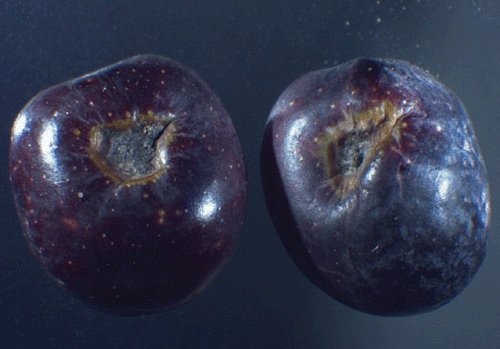First report of Pseudocercospora cladosporioides on olive (Olea europaea) berries in Australia
V. Sergeeva A C , U. Braun B , R. Spooner-Hart A and N. Nair AA Centre for Plant and Food Science, University of Western Sydney, Locked Bag 1797, South Penrith, DC, NSW 1797, Australia.
B Martin Luther Universität, FB. Biologie, Institut für Geobotanik und Botanischer Garten, Herbarium, Neuwerk 21 D-06099 Halle/S, Germany.
C Corresponding author. Email: v.sergeeva@uws.edu.au
Australasian Plant Disease Notes 3(1) 24-24 https://doi.org/10.1071/DN08010
Submitted: 22 January 2008 Accepted: 17 March 2008 Published: 4 April 2008
Abstract
Berry rot caused by Pseudocercospora cladosporioides is reported for the first time on Olea europaea in Australia.
Pseudocercospora cladosporioides (Sacc.) U.Braun (syn. Cercospora cladosporioides, Mycocentrospora cladosporioides) is a common widespread leaf spot disease of olives in most olive growing regions in the world. Cercospora leaf spot of olives has been attributed to P. cladosporioides in Australia (Ávila et al. 2005). In May 2006, we found P. cladosporioides on berries of olives (Olea europaea) in Australia for the first time. It was isolated from berries of the cultivar FS-17 at harvest at an olive grove in Menangle, New South Wales (34°7′S; 150°44′E) (material deposited at the Herbarium of the Martin Luther University, No. 1925 F). The fungus causes small brown sunken spots with greenish boundaries on the surface of the berries (Fig. 1). Infected berries showed signs of rotting. The spots showed the presence of conidiophores and conidia fully agreeing with those on infected leaves where it is commonly found. P. cladosporioides is recognisable by having conidia formed singly, more or less cylindrical, (25–)30–65(–95) × 3–5 µm, (1–)3–5(–7)-septate, very pale to medium olivaceous-brown, with obtuse apex and obconically truncate or subtruncate base (Ávila et al. 2005). P. cladosporioides has been found on olive berries in Spain (del Moral de la Vega and Medina Cabezas 1985).

|
One drop containing 106 spores of P. cladosporioides was placed on each of 10 mature olive berries of variety FS-17. Sterile distilled water was used in the control series. The inoculated berries were placed in a humid chamber and incubated for 10 days at 25°C. After incubation, symptoms of brown sunken spots were visible only on the inoculated berries. Fruit infection by this fungus has not been observed before in Australia, and our report is significant in understanding the epidemiology of the disease. The olive industry in Australia is continuing to expand, and the occurrence of berry rot diseases not previously recorded is of concern. The observation of P. cladosporioides on berries of olives could also be of economic importance because another olive berry infecting fungus (Colletotrichum gloeosporioides) is known to lower the quality of olive oil due to high increase in free acidity and peroxide number (Iannota et al. 1999).
Ávila A,
Groenewald JZ,
Trapero A, Crous PW
(2005
) Characterisation and epitypification of Pseudocercospora cladosporioides, the causal organism of Cercospora leaf spot of olives. Mycological Research 109(
), 881–888.
| Crossref | GoogleScholarGoogle Scholar | PubMed |

del Moral de la Vega J, Medina Cabezas D
(1985
) El “repilo plomizo” del olivo, causado por Cercospora cladosporioides Sacc., enfermedad presente en España. Boletin de Sanidad Vegetal, Plagas 11(
), 31–35.

Iannota N,
Perri E,
Serinni R, Tocci C
(1999
) Influence of Colletotrichum gloeosporioides (Penzic) and Camarosporium dalmatica (Thum) attacks on olive quality. Acta Horticulturae 474(
), 573–576.



